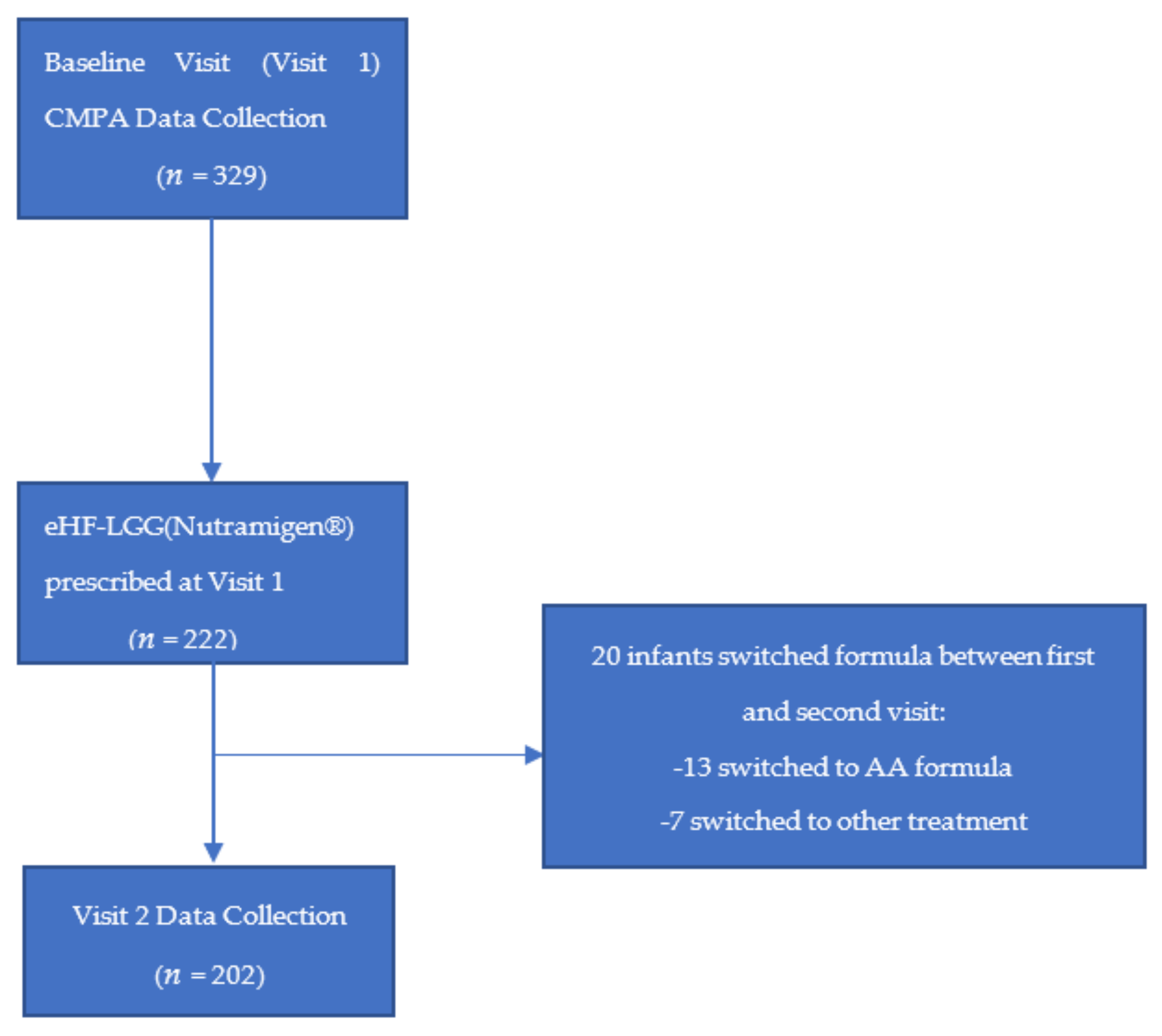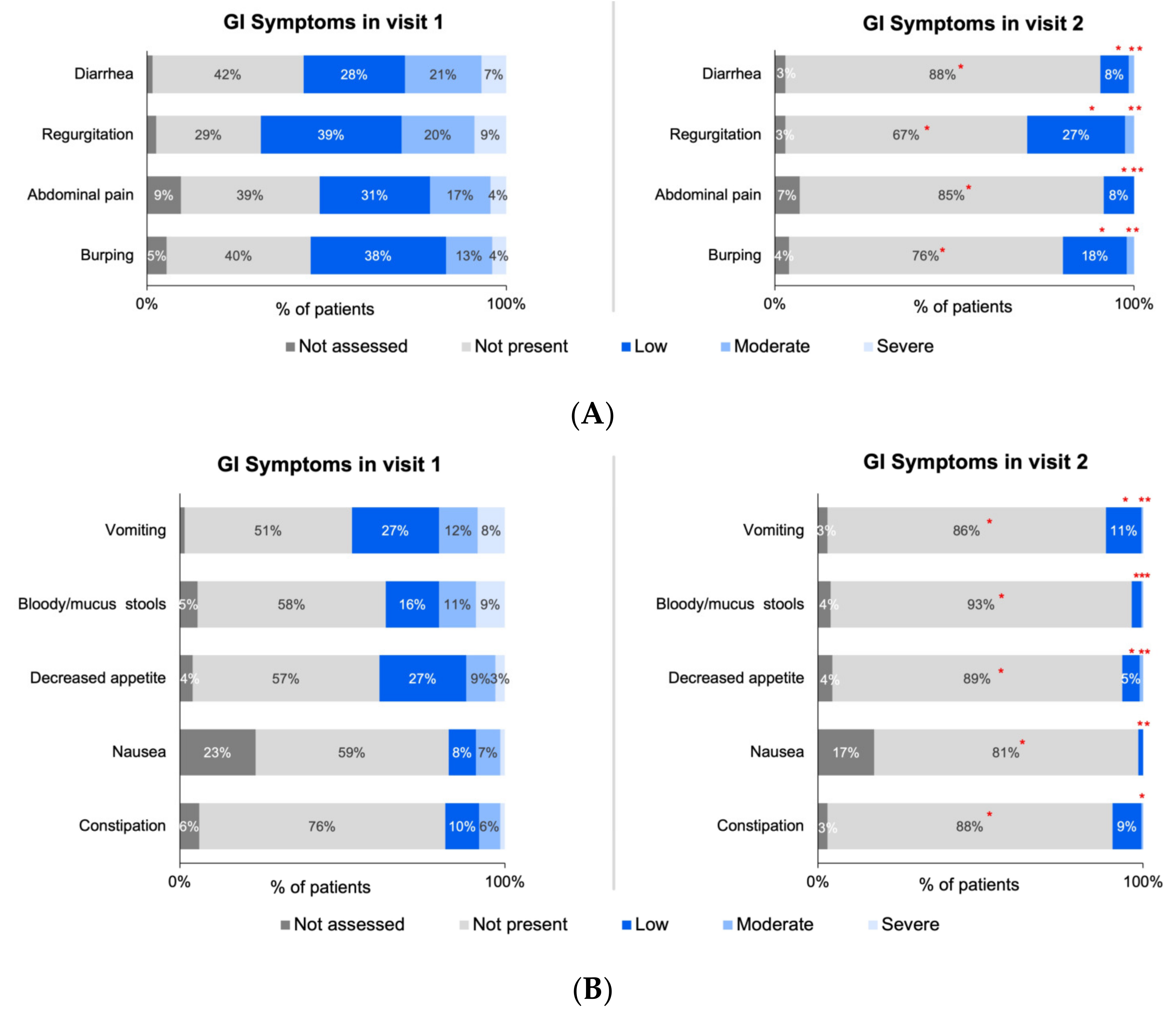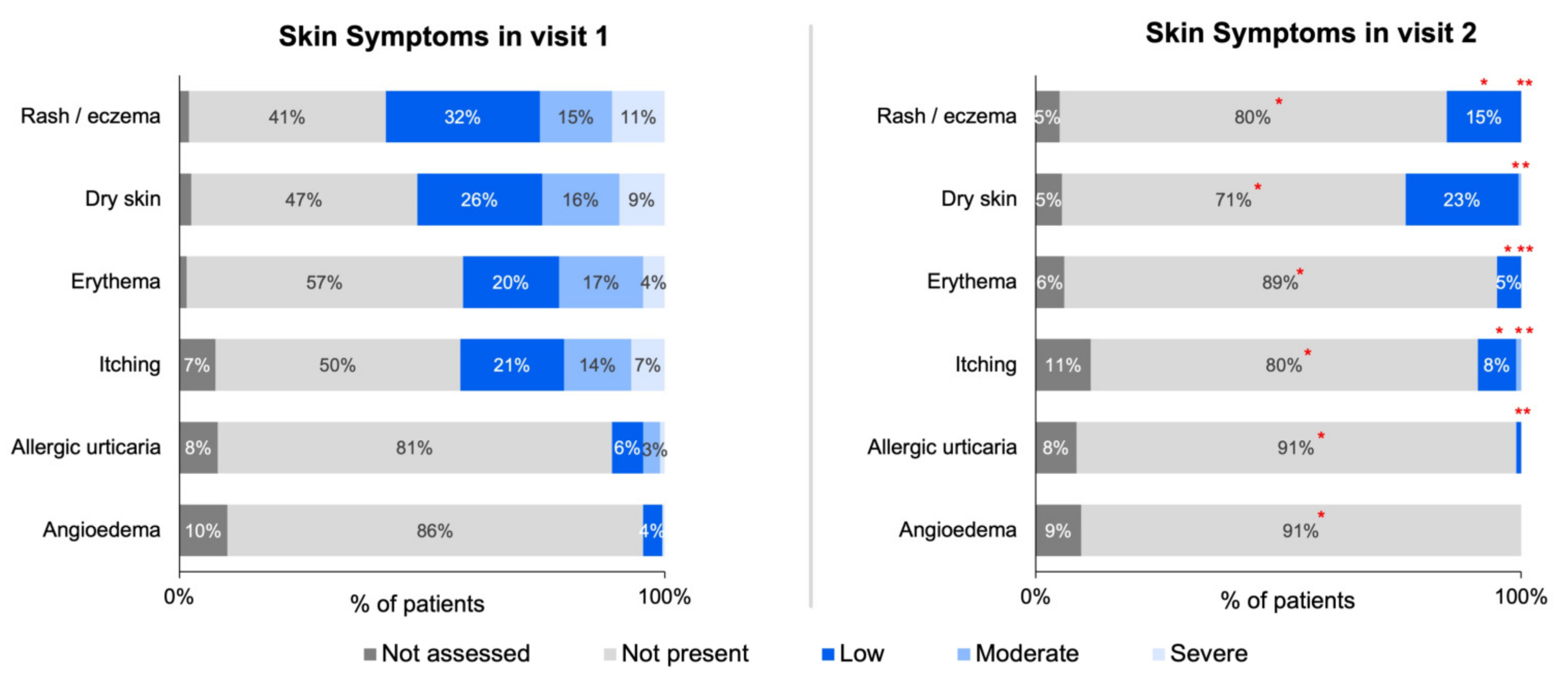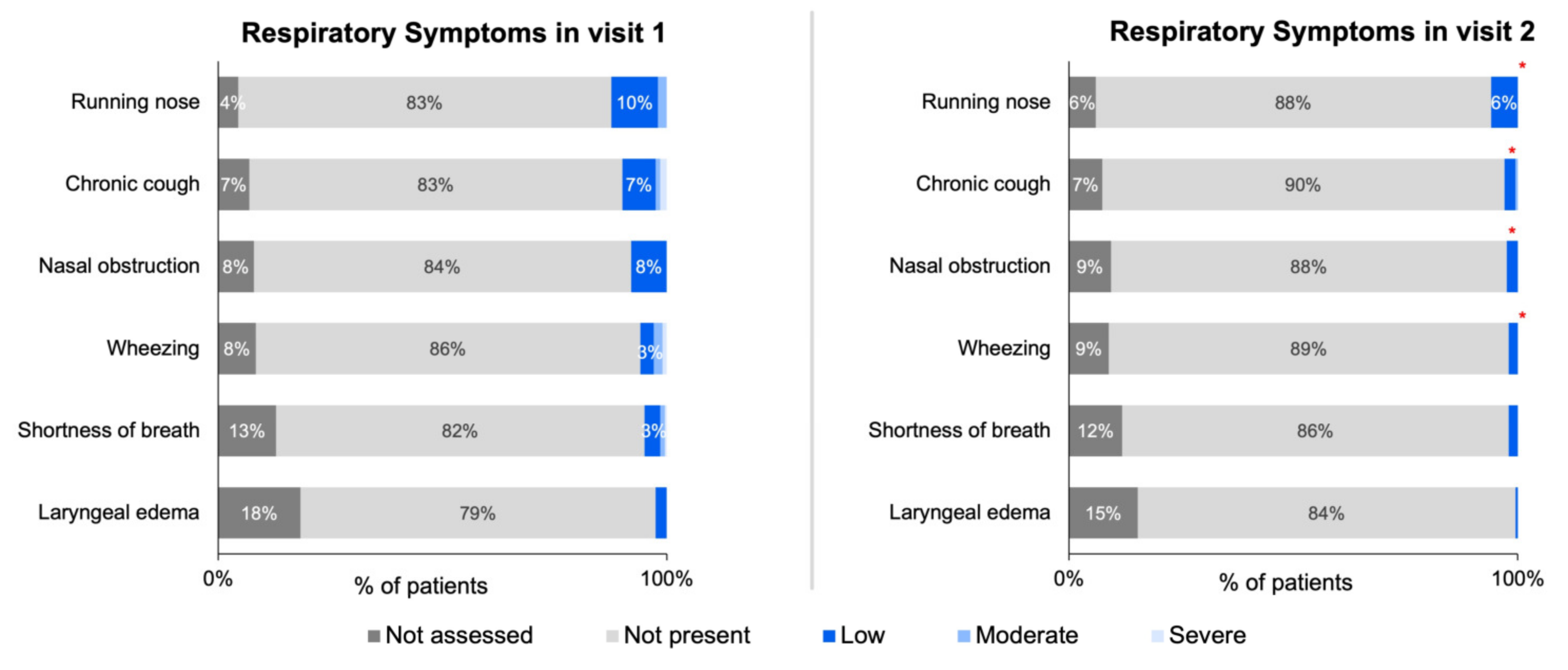Extensively Hydrolyzed Formula Improves Allergic Symptoms in the Short Term in Infants with Suspected Cow’s Milk Protein Allergy
Abstract
1. Introduction
2. Materials and Methods
2.1. Study Design and Participants
2.2. Data Collection
2.3. Statistical Analyses
3. Results
4. Discussion
5. Conclusions
Supplementary Materials
Author Contributions
Funding
Institutional Review Board Statement
Informed Consent Statement
Data Availability Statement
Acknowledgments
Conflicts of Interest
References
- Mousan, G.; Kamat, D. Cow’s Milk Protein Allergy. Clin. Pediatr. 2016, 55, 1054–1063. [Google Scholar] [CrossRef] [PubMed]
- Caffarelli, C.; Baldi, F.; Bendandi, B.; Calzone, L.; Marani, M.; Pasquinelli, P.; EWGPAG. Cow’s milk protein allergy in children: A practical guide. Ital. J. Pediatr. 2010, 36, 5. [Google Scholar] [CrossRef] [PubMed]
- Ludman, S.; Shah, N.; Fox, A.T. Managing cows’ milk allergy in children. BMJ 2013, 347, f5424. [Google Scholar] [CrossRef] [PubMed]
- Lemale, J.; Decline, J.L.; Dive-Pouletty, C.; Touboul, C.; Pichon, N.; Dupont, C. Managing Cow’s Milk Protein Allergy with an Extensively Hydrolyzed Formula: Results from a Prospective, Non-Interventional Study in France (EVA Study). Nutrients 2022, 14, 1203. [Google Scholar] [CrossRef]
- Luyt, D.; Ball, H.; Makwana, N.; Green, M.R.; Bravin, K.; Nasser, S.M.; Clark, A.T. Standards of Care Committee (SOCC) of the British Society for Allergy and Clinical Immunology (BSACI). BSACI guideline for the diagnosis and management of cow’s milk allergy. Clin. Exp. Allergy 2014, 44, 642–672. [Google Scholar] [CrossRef]
- Sekkidou, M.; Muhardi, L.; Constantinou, C.; Kudla, U.; Vandenplas, Y.; Nicolaou, N. Nutritional Management With a Casein-Based Extensively Hydrolysed Formula in Infants With Clinical Manifestations of Non-IgE-Mediated CMPA Enteropathies and Constipation. Front. Allergy 2021, 2, 676075. [Google Scholar] [CrossRef]
- Flom, J.D.; Sicherer, S.H. Epidemiology of Cow’s Milk Allergy. Nutrients 2019, 11, 1051. [Google Scholar] [CrossRef]
- Host, A.; Halken, S. Cow’s milk allergy: Where have we come from and where are we going? Endocr. Metab. Immune Disord. Drug Targets 2014, 14, 2–8. [Google Scholar] [CrossRef]
- Koletzko, S.; Niggemann, B.; Arato, A.; Dias, J.A.; Heuschkel, R.; Husby, S.; Mearin, M.L.; Papadopoulou, A.; Ruemmele, F.M.; Staiano, A.; et al. European Society of Pediatric Gastroenterology, Hepatology, and Nutrition. Diagnostic approach and management of cow’s-milk protein allergy in infants and children: ESPGHAN GI Committee practical guidelines. J. Pediatr. Gastroenterol. Nutr. 2012, 55, 221–229. [Google Scholar] [CrossRef]
- Dupont, C.; Chouraqui, J.P.; de Boissieu, D.; Bocquet, A.; Bresson, J.L.; Briend, A.; Darmaun, D.; Frelut, M.L.; Ghisolfi, J.; Girardet, J.P.; et al. French Society of Paediatrics. Dietary treatment of cows’ milk protein allergy in childhood: A commentary by the Committee on Nutrition of the French Society of Paediatrics. Br. J. Nutr. 2012, 107, 325–338. [Google Scholar] [CrossRef]
- Berni Canani, R.; Di Costanzo, M.; Bedogni, G.; Amoroso, A.; Cosenza, L.; Di Scala, C.; Granata, V.; Nocerino, R. Extensively hydrolyzed casein formula containing Lactobacillus rhamnosus GG reduces the occurrence of other allergic manifestations in children with cow’s milk allergy: 3-year randomized controlled trial. J. Allergy Clin. Immunol. 2017, 139, 1906–1913.e4. [Google Scholar] [CrossRef]
- Scalabrin, D.; Harris, C.; Johnston, W.H.; Berseth, C.L. Long-term safety assessment in children who received hydrolyzed protein formulas with Lactobacillus rhamnosus GG: A 5-year follow-up. Eur. J. Pediatr. 2017, 176, 217–224. [Google Scholar] [CrossRef]
- Berni Canani, R.; Nocerino, R.; Terrin, G.; Frediani, T.; Lucarelli, S.; Cosenza, L.; Passariello, A.; Leone, L.; Granata, V.; Di Costanzo, M.; et al. Formula selection for management of children with cow’s milk allergy influences the rate of acquisition of tolerance: A prospective multicenter study. J. Pediatr. 2013, 163, 771–777.e1. [Google Scholar] [CrossRef]
- Sackesen, C.; Altintas, D.U.; Bingol, A.; Bingol, G.; Buyuktiryaki, B.; Demir, E.; Kansu, A.; Kuloglu, Z.; Tamay, Z.; Sekerel, B.E. Current Trends in Tolerance Induction in Cow’s Milk Allergy: From Passive to Proactive Strategies. Front. Pediatr. 2019, 7, 372. [Google Scholar] [CrossRef]
- Berni Canani, R.; Nocerino, R.; Terrin, G.; Coruzzo, A.; Cosenza, L.; Leone, L.; Troncone, R. Effect of Lactobacillus GG on tolerance acquisition in infants with cow’s milk allergy: A randomized trial. J. Allergy Clin. Immunol. 2012, 129, 580–582.e5. [Google Scholar] [CrossRef]
- Niggemann, B.; von Berg, A.; Bollrath, C.; Berdel, D.; Schauer, U.; Rieger, C.; Haschke-Becher, E.; Wahn, U. Safety and efficacy of a new extensively hydrolyzed formula for infants with cow’s milk protein allergy. Pediatr. Allergy Immunol. 2008, 19, 348–354. [Google Scholar] [CrossRef]
- Savino, F.; Montanari, P.; Galliano, I.; Daprà, V.; Bergallo, M. Lactobacillus rhamnosus GG (ATCC 53103) for the Management of Infantile Colic: A Randomized Controlled Trial. Nutrients 2020, 12, 1693. [Google Scholar] [CrossRef]
- Lee, S.W. Methods for testing statistical differences between groups in medical research: Statistical standard and guideline of Life Cycle Committee. Life Cycle 2022, 2, e1. [Google Scholar] [CrossRef]
- Vandenplas, Y.; Mukherjee, R.; Dupont, C.; Eigenmann, P.; Høst, A.; Kuitunen, M.; Ribes-Koninkx, C.; Shah, N.; Szajewska, H.; von Berg, A.; et al. Protocol for the validation of sensitivity and specificity of the Cow’s Milk-related Symptom Score (CoMiSS) against open food challenge in a single-blinded, prospective, multicentre trial in infants. BMJ Open 2018, 8, e019968. [Google Scholar] [CrossRef]
- Kansu, A.; Yüce, A.; Dalgıç, B.; Şekerel, B.E.; Çullu-Çokuğraş, F.; Çokuğraş, H. Consensus statement on diagnosis, treatment and follow-up of cow’s milk protein allergy among infants and children in Turkey. Turk. J. Pediatr. 2016, 58, 1–11. [Google Scholar] [CrossRef]
- Thompson-Chagoyan, O.C.; Fallani, M.; Maldonado, J.; Vieites, J.M.; Khanna, S.; Edwards, C.; Doré, J.; Gil, A. Faecal microbiota and short-chain fatty acid levels in faeces from infants with cow’s milk protein allergy. Int. Arch. Allergy Immunol. 2011, 156, 325–332. [Google Scholar] [CrossRef] [PubMed]
- Thompson-Chagoyan, O.C.; Vieites, J.M.; Maldonado, J.; Edwards, C.; Gil, A. Changes in faecal microbiota of infants with cow’s milk protein allergy—A Spanish prospective case-control 6-month follow-up study. Pediatr. Allergy Immunol. 2010, 21 Pt 2, e394–e400. [Google Scholar] [CrossRef] [PubMed]
- Guadamuro, L.; Diaz, M.; Jiménez, S.; Molinos-Norniella, C.; Pérez-Solis, D.; Rodríguez, J.M.; Bousoño, C.; Gueimonde, M.; Margolles, A.; Delgado, S.; et al. Fecal Changes Following Introduction of Milk in Infants With Outgrowing Non-IgE Cow’s Milk Protein Allergy Are Influenced by Previous Consumption of the Probiotic LGG. Front. Immunol. 2019, 10, 1819. [Google Scholar] [CrossRef] [PubMed]
- Rona, R.J.; Keil, T.; Summers, C.; Gislason, D.; Zuidmeer, L.; Sodergren, E.; Sigurdardottir, S.T.; Lindner, T.; Goldhahn, K.; Dahlstrom, J.; et al. The prevalence of food allergy: A meta-analysis. J. Allergy Clin. Immunol. 2007, 120, 638–646. [Google Scholar] [CrossRef]
- Vandenplas, Y.; Zhao, Z.Y.; Mukherjee, R.; Dupont, C.; Eigenmann, P.; Kuitunen, M.; Ribes Koninckx, C.; Szajewska, H.; von Berg, A.; Bajerová, K.; et al. Assessment of the Cow’s Milk-related Symptom Score (CoMiSS) as a diagnostic tool for cow’s milk protein allergy: A prospective, multicentre study in China (MOSAIC study). BMJ Open 2022, 12, e056641. [Google Scholar] [CrossRef]






| Item | Population |
|---|---|
| Demographics | |
| Male | n = 99 (49%) |
| Female | n = 103 (51%) |
| Age at enrollment (months) | |
| ● Median | 3 |
| ● Mean | 2.9 |
| Time Between First and Second Visit | |
| ● 3 weeks | n = 34 (17%) |
| ● 4 weeks | n = 22 (10%) |
| ● 5 Weeks | n = 70 (35%) |
| ● >5 weeks | n = 76 (38%) |
| Family Allergy History | n = 113 (51%) |
| CMPA Diagnosis Parameters | |
| Time of Diagnosis | |
| ● Newly Diagnosed | n = 150 (74%) |
| ● Already Under Treatment | n = 72 (26%) |
| Method of Diagnosis | |
| ● Clinical Assessment | n = 190 (94%) |
| ● Elimination Diet | n = 89 (44%) |
| ● Family History | n = 99 (49%) |
| ● Skin Prick Test | n = 8 (4%) |
| ● Food Panel Tests | n = 10 (5%) |
| ● sIgE assay/ABMK allergen component assay | n = 6 (3%) |
| ● Atopic Patch Test | n = 6 (3%) |
| ● Food antigen rechallenge | n = 4 (2%) |
| CMPA Management Strategies | |
| eHF LGG (Nutramigen®) | n = 202 (100%) |
| Probiotics | n = 102 (50%) |
| Breastfeeding | n = 51 (25%) |
| Antihistamines | n = 54 (27%) |
| HCP Demographics | |
| Primary Specialty | |
| ● General Pediatrics | n = 45 (87%) |
| ● Pediatric GI | n = 3 (6%) |
| ● Pediatric A/I | n = 3 (6%) |
| ● General GI | n = 1 (2%) |
| Patient Volume (Patients/week) | |
| ● 2–4 | n = 22 (42%) |
| ● 5–10 | n = 20 (38%) |
| ● 11–20 | n = 9 (17%) |
| ● >20 | n = 1 (2%) |
| Symptom (N 1) | # Patient Symptom Improvement (%) 2 |
|---|---|
| Diarrhea (n = 117) | 105 (90%) |
| Regurgitation (n = 142) | 105 (74%) |
| Abdominal pain (n = 105) | 95 (90%) |
| Belching/Burping (n = 118) | 94 (80%) |
| Vomiting (n = 97) | 83 (86%) |
| Bloody mucoid/stool (n = 74) | 70 (95%) |
| Decreased appetite (n = 76) | 69 (91%) |
| Nausea (n = 35) | 34 (97%) |
| Constipation (n = 46) | 31 (67%) |
| Symptom (N 1) | # Patient Symptom Improvement (%) 2 |
|---|---|
| Rash/eczema (n = 117) | 101 (86%) |
| Dry Skin (n = 113) | 86 (76%) |
| Erythema (n = 85) | 80 (94%) |
| Itching (n = 90) | 76 (84%) |
| Allergic urticaria (n = 23) | 21 (91%) * |
| Angioedema (n = 7) | 7 (100%) * |
| Symptom (N 1) | # Patient Symptom Improvement (%) 2 |
|---|---|
| Running nose (n = 30) | 20 (67%) |
| Chronic cough (n = 23) | 19 (83%) * |
| Nasal Obstruction (n = 17) | 14 (82%) * |
| Wheezing (n = 15) | 11 (73%) * |
| Shortness of breath (n = 12) | 8 (67%) * |
| Laryngeal edema (n = 4) | 4 (100%) * |
| Symptom (N 1) | # Patient Symptom Improvement (%) 2 |
|---|---|
| Abnormal growth/weight gain (n = 62) | 56 (90%) |
| Watery Eyes (n = 23) | 21 (91%) * |
| Pallor, pale color skin (n = 23) | 18 (78%) * |
| Conjunctival redness (n = 16) | 16 (100%) * |
| Sweating after meal (n = 18) | 16 (89%) * |
Disclaimer/Publisher’s Note: The statements, opinions and data contained in all publications are solely those of the individual author(s) and contributor(s) and not of MDPI and/or the editor(s). MDPI and/or the editor(s) disclaim responsibility for any injury to people or property resulting from any ideas, methods, instructions or products referred to in the content. |
© 2023 by the authors. Licensee MDPI, Basel, Switzerland. This article is an open access article distributed under the terms and conditions of the Creative Commons Attribution (CC BY) license (https://creativecommons.org/licenses/by/4.0/).
Share and Cite
Wilsey, M.J.; Florio, J.; Beacker, J.; Lamos, L.; Baran, J.V.; Oliveros, L.; Sriaroon, P.; Brown, J.M.; Vanderhoof, J.A. Extensively Hydrolyzed Formula Improves Allergic Symptoms in the Short Term in Infants with Suspected Cow’s Milk Protein Allergy. Nutrients 2023, 15, 1677. https://doi.org/10.3390/nu15071677
Wilsey MJ, Florio J, Beacker J, Lamos L, Baran JV, Oliveros L, Sriaroon P, Brown JM, Vanderhoof JA. Extensively Hydrolyzed Formula Improves Allergic Symptoms in the Short Term in Infants with Suspected Cow’s Milk Protein Allergy. Nutrients. 2023; 15(7):1677. https://doi.org/10.3390/nu15071677
Chicago/Turabian StyleWilsey, Michael J., Jared Florio, Jesse Beacker, Luke Lamos, Jessica V. Baran, Lea Oliveros, Panida Sriaroon, Jerry M. Brown, and Jon A. Vanderhoof. 2023. "Extensively Hydrolyzed Formula Improves Allergic Symptoms in the Short Term in Infants with Suspected Cow’s Milk Protein Allergy" Nutrients 15, no. 7: 1677. https://doi.org/10.3390/nu15071677
APA StyleWilsey, M. J., Florio, J., Beacker, J., Lamos, L., Baran, J. V., Oliveros, L., Sriaroon, P., Brown, J. M., & Vanderhoof, J. A. (2023). Extensively Hydrolyzed Formula Improves Allergic Symptoms in the Short Term in Infants with Suspected Cow’s Milk Protein Allergy. Nutrients, 15(7), 1677. https://doi.org/10.3390/nu15071677





